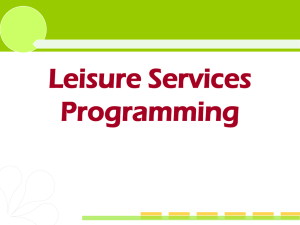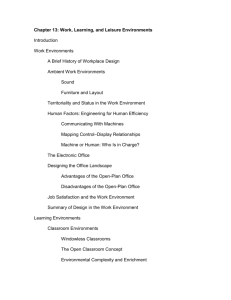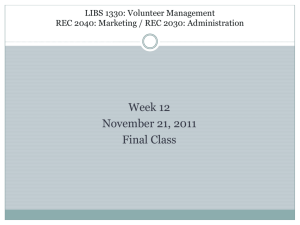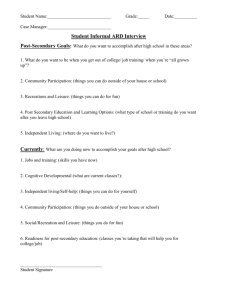Planning v.s. Programming
advertisement
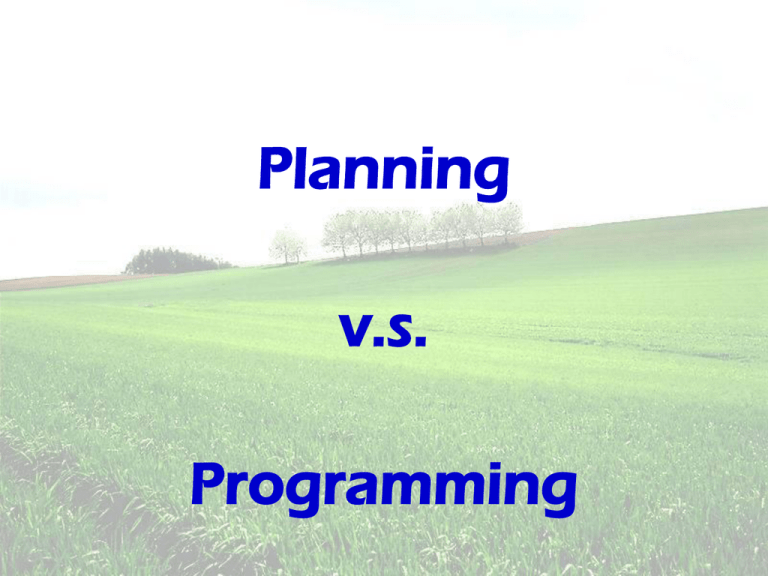
Planning v.s. Programming Programming is the single most important product of a leisure and recreation organization休閒遊憩組織最重要的產品, why? The opportunity for people to enjoy leisure is made available through programming 藉由企劃人們才能有機會享 受休閒 p. 447 Programming must achieve optimal use of existing resources已存資源的最佳使用 (…) to meet the goals of the organization and the needs of people以同時滿足組織和人群 的需求 Leisure programming Consists of planning, scheduling, timetabling and implementing action which uses resources, facilities and staff to offer a wide range of services and activities. 透過休閒活動去培養個人營造生動活潑的 休閒經驗 A balanced program平衡企畫 would 包含? Balanced Program Features Opportunities to: activities on a structured and informal basis actively, passively or creatively as an individual or group regular core program as well as a variable program competition, audience and spectator special events Who Does programming? The commercial sector Institutional sector Voluntary sector The local government sector Who Does programming? Balanced programs giving equal opportunity to all is extremely difficult to fashion. “There is nothing more unequal than the equal treatment of unequals” What Constitutes a Program? Activities: Amenities: Services Staff人員 Money Program Classification Why to learn分類 ? Balance of program types Function功能 Facilities設施 People人 Outcomes結果 社區遊憩企畫 The total experiences of individuals and groups resulting from community action in providing areas, facilities, leadership and funds, 企劃的成功 ? Programming Strategies Community development社區發展: programs which emanate from the community itself Social planning社會規劃: planned programs directed professionally by officers or authorities Approach Differences Important difference? p. 452 View Involved tasks Working groups Skills The programs are only successful as long as the support is available over a sustained period of time Which one is used the most by the local authorities? Why? Which one is better? Lessons from past mistakes Demands and needs not being assessed Objectives not measurable Too traditional and static Lack of variety and novelty “Take it or leave it” approach User systems not evaluated p. 457 Need to balance casual use with club use and events on policy Lack of analyzing the benefits and problems Client life-flow patterns are broken? Program patterns are not given due consideration Incompatible activities are programmed together Insufficient flexibility to adapt to new demands Ways of expanding an already busy program are poorly explored IT and computer systems used rarely Programs contain imbalance Program worth is increasingly judged on numbers Risk avoidance leads to a lack-lustre approach Facilities are used for single purpose Not considering outreach possibilities Program monitoring and systematic evaluation are rarely carried out Programming by Objectives Interpret policy政策, establish aims and objectives目標 p. 461 Assess resources and current and potential demand Set objectives – BBP model Plan the program – Program areas主題 and formats參與類型 Promote, implement and control the program Evaluate the program Obtain feedback回饋 and modify the program appropriately Elements in creating the leisure experience Social environment社會環境 Physical environment實體環境 Natural environment自然環境 Activity Programming 藉由活動將休閒體驗提供給參與者, 利用收 集到的資訊, 配合活動單位的目標來進行設 計 遊憩體驗是一動態過程, 影響因素? 六個活動企劃元素 參與互動者 實質情境 休閒事物 規則 參與者之間的關係 活化活動 設計活動的過程即操控或創造這六個關鍵元 素之一來促進休閒體驗 What do people seek from leisure? Benefits sought – an improved condition or desired change of state Recreation Experience Opportunity From a managerial perspective, the most important tasks are to understand: Which psychological outcomes心理結果 are perceived to be most satisfying by particular types of recreationists who are engaging in desired activities within preferred settings Customers buy expectations or benefits of benefits - Cosmetics, 珍珠粉 遊憩體驗階段 Anticipation Travel to On-site Travel back Recollection Programmers 通常於何時介入? Benefits-Based Management 全面管理策略, 公園與遊憩機構行銷管理的 新方法, 讓人們了解公園與遊憩機構對 人們的好處 Benefits-Based Awareness Benefits-Based Programming, BBP Benefits-Based Programming 結果導向, 為特定對象創造具體利益, 作為 參與者參加特定活動之成果, 同時也利於取 得社會認同及財務資源 Program Areas Leisure activities may be classified based on types of activities活動, amount and kind of involvement by the customer消費者涉入量 和類型, activity settings活動情境, activity benefits活動效益, … Emerging Areas of Program Importance Youth Programming – youth at risk, much time available, fun morality Family Programming Program Formats The configuration or way in which experiences are sequenced排序 and linked to one another to increase the likelihood that customers will achieve desired benefits 企畫者需知可傳遞休閒體驗leisure experiences的各種結構 The program format 直接與個人休閒體驗 有關 滿意度satisfaction (the pleasure that one derives from participation in an organized leisure service program) 選擇 program format時, the manager is 預 先決定部分人的滿意程度 while limiting the probability that others will occur Program Matrix 須針對六元素及目標來考量 蚊子電影 創意戲劇 行動圖書 秋日小徑兜風 默劇劇團
